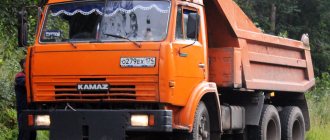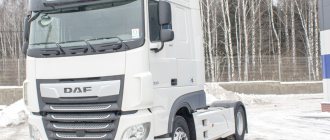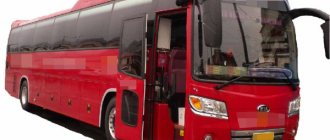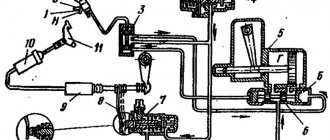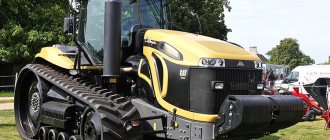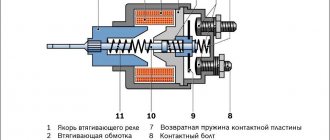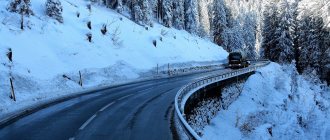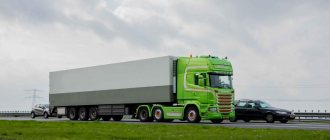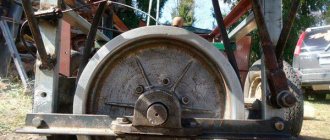Driving a truck is not an easy process, especially when it comes to a tractor-trailer. To operate this complex structure, you need serious experience and theoretical training. An exercise such as reversing parking or other similar maneuvers is not easy for all novice drivers. And probably no one succeeds in driving a truck backwards the first time.
The principles of driving backwards on a truck and a passenger vehicle with a trailer are largely similar. But given the dimensions of the truck or trailer, maneuvering it has its own peculiarities.
What is turning radius
Many car enthusiasts are “out of the loop,” and rarely do any of them know what a truck’s turning radius is.
According to special technical literature, this is an imaginary arc along the line of which the center of gravity of a tractor with a semi-trailer moves when performing complex maneuvering. The maximum value of this value (radius) largely depends on the specific design of the vehicle. Here's how a truck can hit a passenger car with its semi-trailer while turning:
There is a special term - design vehicle, its tactical and technical indicators are used in the development of projects for regional routes. Such parameters, for example: the size and R min of the turn must be identical for each class of vehicle.
European standards regulate the following dimensions for heavy-duty vehicles when cornering:
- with an external R of 12.5 m, the internal R will be equal to or less than 5.3 m;
- corridor for fitting into a turn - 7.2 m;
- R min external should not exceed 12.5 m.
For example: for a road train of type A16, which has a linear dimension of up to 16 meters, and a similar type of A20 with a length of up to 20 m, there are strict restrictions specified in the table below:
| Vehicle type | R min turn, m | R min external, m | R min internal, m |
| A16 | 9,7 | 10,2 | 6,2 |
| A20 | 12,1 | 12,6 | 8,5 |
Typical prototypes for design vehicles include:
- road train up to 16 m - MAN F-200019.403 FLT or European truck with dimensions 16.5 × 2.5 m, where the first parameter is linear, and the second is width;
- The 20-meter version is Mercedes-Benz Actros or SZAP-8357A, with dimensions of 19.8 by 2.5 m.
Road trains with two or three trailers, having a length of more than 20 meters, are used by all carriers in the world, therefore, when developing highway layouts, it is necessary to carry out additional computer modeling of such specific movement during turns at road intersections or city intersections.
Road train on the road
Test drive KAMAZ 43118
First, we test the truck on a route simulating city traffic. Here the car shows good results both in terms of dynamics and fuel consumption, which amounted to 32.5 liters per hundred when driving at an average speed of 38.6 km/h. The figure for a heavy all-wheel drive truck is quite decent.
Having made several laps along the route on our own and with a test driver, we come to the conclusion that the gear shift drive is insufficiently reliable. On each lap of the route, which was 18 km, three to five errors regularly occurred when changing gears.
Most likely, the problem arose due to the selection being too small. The optimal shifting algorithm when driving a car without a load in top gear turned out to be 2-4-6-7.
Next, the truck was tested on a dynamometer road. Having warmed up the engine sufficiently, we accelerate it to maximum speed, and with surprise we determine the speed is 125 km/h, which is very good for an all-wheel drive truck of this class. We were also pleasantly surprised by the fuel consumption figures, which amounted to 18.4 liters at a speed of 50 km/h and 27.8 when driving at a speed of 80 km/h.
The next step was the primer. Driving over bumps and potholes on such a suspension is a dubious pleasure. The dirt test section is replete with all sorts of descents and steep climbs, and we did not expect to ride along it in the test KamAZ in comfort; speed capabilities on the ground were not tested at all, since here the only task was to simply stay in place and continue working with the equipment.
However, there are no critical remarks about the car here; we can only point out that the shaking is too strong when driving through sections of the road with uneven surfaces.
Testing a loaded vehicle
The empty vehicle testing is completed and the vehicle is loaded with ballast to continue testing. Now, with an already loaded car, we repeat the races along all routes. On a track simulating a city road, a loaded vehicle weighing more than 21 tons demonstrates good dynamics. Eight main gears and one reduction gear fully satisfy the needs of the engine.
Engine KAMAZ 740.30-260
In the loaded version, the optimal switching algorithm when the car is moving in top gear turned out to be 1-3-5-6-7. However, when driving under a load, fuel consumption indicators increased significantly.
Last but not least, an increase in rolling resistance of loaded tires could contribute to the decrease in fuel efficiency. The speed decreased by only 1.3 km/h.
A similar picture of fuel consumption was present when passing a section of the dynamometer road. The loaded car, in the maximum speed test, managed to accelerate to 102.8 km/h.
When driving under a load, sometimes you get the feeling that the engine is slightly lacking in power, although its values are quite consistent with the parameters of the car.
Slopes
The turning radius of a car: how to measure and whether it can be changed.
Roads passing through rough terrain practically repeat its profile, where ascents alternate with descents. Slopes (rises) running along the center line of the roadway are called longitudinal.
To ensure the drainage of water from the roadway, it is arranged in such a way that the edges of the roadway are located below its middle (gable profile). The resulting slopes are called transverse.
In some sections of the road curves, its carriageway may be uniformly lowered from the outer side of the curve to the inner (bend, single-pitch profile).
Cross slopes are measured in a direction perpendicular to the center line of the road.
You can determine the longitudinal slope angle of the road in the following way:
- in the middle of the roadway, the end of the tape measure is fixed with an o (press with a stone, vehicle wheel, etc.)
- the roulette is unwound, and with the help of an observer the roulette sheet is given a horizontal position
- the distance from the surface of the roadway to the tape measure is measured (a), against one of its divisions 3, 5 or 10 m (b)
The measurement results are recorded schematically and entered into the protocol. The length of the slope should also be measured and indicated in the protocol.
Measurements to determine the magnitude of the transverse slope or superelevation of the roadway are made in a similar way in the direction perpendicular to the axis of the road.
Maneuvering Features
Difficulty turning right at the arrow
Truck drivers have specific training: they confidently take turns on the highway and while moving around the city, when passing intersections, because the movements are trained to automaticity on special tracks of the autodrome, as shown in this video:
Such a term as the turning radius of a truck should be taken into account when developing access roads to warehouses and unloading sites for large-capacity vehicles. And the turning area for a truck must comply with approved standards so that a heavy vehicle can confidently maneuver in the territory allocated for these purposes.
Table of platform width for vehicles (vehicles)
| Car type | Vehicle length in m | Platform width, m |
| Kamaz | 10 | 22 |
| Eurotruck | 18 | 38 |
Eurotruck turning radius
European standards regulate length restrictions, for example, for a semi-trailer train this parameter is 16.5 meters. Semi-trailer dimensions: 12 m from the SSU axle to the rear and 2.1 m to the front bumper.
The standard turning radius of a Eurotruck, for example, 180 or 360 degrees within an imaginary area, which is composed of two circles with R = 12.5 m and 5.3 m, must be freely carried out, provided that the protruding parts of the vehicle do not cross the designated boundaries during maneuvering .
Schematic illustration of a truck's turning radius
American's turning radius
Tractors with semi-trailers, developed by American designers, are called trucks, and maneuverability, especially when driving around the city, is limited due to their large linear size. To turn 90 degrees, such a large vehicle requires 2 times more radius than its European counterparts. Therefore, sometimes you have to see situations such as in the photo.
Incorrect turn of the truck
In urban areas, such vehicles cannot operate without accidents, so as not to constantly violate traffic rules; they make it difficult for other vehicles to move, since their length does not meet European standards. Car owners are forced to keep their distance from the “Americans” to avoid being hit by the unfolding “monster.”
KamAZ-55111: main operational and technical characteristics
Dimensions and load capacity
- Dump truck height: 2,995 millimeters;
- Length: 6,690 mm;
- Width excluding mirrors: 2,500 mm;
- Center distance: 2,840 – 3,190 mm;
- Ground clearance: 290 mm;
- Maximum outer turning radius: 9 meters;
- Platform volume: 6.6 cubes;
- Curb weight of the truck: 9,150 kilograms;
- Load capacity: 13,000 kg;
- Total loaded vehicle weight: 23,125 kg;
- Total weight of the road train: 35.1 tons;
- Maximum platform elevation angle: 60 0 ;
- Maximum climbing angle: 25%;
- Wheel type: disc
- Tire type: pneumatic, tube
- Tire size: 10.00 R20 (280 R508)11.00 R20 (300 R508)
- The highest speed of the truck: 90 km/h.
Power unit and fuel consumption of KamAZ-55111
The domestically produced diesel engine 740.51-240 was chosen as the main power unit for this model. This eight-cylinder diesel engine is distinguished by a V-shaped cylinder arrangement, it has a turbocharging function and a cooling system for the consumed air. The working volume of the power unit is 10.86 liters, it develops a rated power of 240 hp at a rotation speed of 2,200 rpm. The engine uses cooling technology in which the fan is driven through a special fluid coupling. Thus, a sharp change in the angular speed of the fan when the engine speed drops or increases is eliminated. The motor is not highly environmentally friendly; it complies with Euro 2 standards.
It should be mentioned that a small number of KamAZ-55111 dump trucks were equipped with a six-cylinder YaMZ-236 engine with a power of 180 hp.
The manufacturer's declared fuel consumption per 100 kilometers is 30 liters. However, this norm can only be achieved when driving on a good road, at a speed of 50-60 km/h. When the speed increases to 80-90 km/h, fuel consumption indicators increase sharply and can differ significantly from the norm. The KamAZ-55111 dump truck is equipped as standard with a 250-liter fuel tank. However, small batches of trucks left the factory, equipped with a tank with a volume of 350 liters, which significantly increased the vehicle’s mileage without refueling.
Transmission and power supply KamAZ-55111
The car is equipped with two manual gearboxes: a five-speed gearbox without a divider with a three-way shift mechanism, with a gear ratio of 7.22, and a ten-speed gearbox with a transfer number of 6.53. To transmit force from the engine to the gearbox, a double-disc diaphragm clutch equipped with a hydraulic drive with a pneumatic booster is used. The clutch and gearbox are controlled remotely from the driver's cabin.
The electrical systems of the KamAZ-55111 dump truck are powered by two 12-volt batteries with a total capacity of 380 A/hour. In addition, the truck is equipped with a voltage regulator and a two-kilowatt 28-volt generator.
Cornering
Calculation of gear ratios of a gearbox
Experienced truck drivers feel the dimensions of a vehicle consisting of a tractor and a semi-trailer with an uncontrolled trolley, as well as the difficulties arising associated with the displacement of the latter when entering a turn.
Gracefully passing an intersection
Much more attention is required by the truck driver when maneuvering within the city, where there is heavy traffic of pedestrians, as well as cars and public transport. Particularly noteworthy are the difficulties when driving through junctions and intersections - all necessary maneuvers to change direction and change lanes must be performed in advance, but no closer than 20 meters from the beginning of the junction or road intersection.
When making a right turn, you should pay attention to the oncoming lane of the road, because
the road train often drives onto it to avoid the wheels of the semi-trailer truck from driving onto the curb, creating a risk of injury to pedestrians. When turning left, you should not try to pass the center of the intersection, because the turning area increases, which makes it difficult for other vehicles to move in the right direction.
Errors in turning
ERRORS, after which the traffic police exam will NOT BE PASSED!
Remember the list of mistakes below and try not to make them under any circumstances.
The traffic police exam will NOT be PASSED if:
- Start performing the test exercise 30 seconds after receiving the command (signal) to start performing it.
- GO beyond the boundaries of exercise areas marked with solid marking lines.
- RUN the wheel onto the solid marking line marking the boundaries of the exercises or KNOCK down the cone (stand) 3 times or more.
- Deviate from the given trajectory of movement.
- Engage reverse gear if this is not provided by the Regulations.
- CROSS the STOP line even with the edge of the front bumper.
- Do not drive completely beyond the control line after reversing.
- “Stop the engine” (allow it to stop) 3 times or more.
- On the inclined section of the “Overpass”, allow a rollback of more than 30 cm.
- Stop more than 1 meter before the “STOP-2” marking line for the “Overpass” exercise.
- Violate the rules for driving through an intersection (on an automated racing track)
- Exceed the total time for performing test exercises.
- Leave the exam or refuse to do the exercise.
We have analyzed in detail the mistakes that are prohibited to be made during the traffic police exam “PLATFORM”, but now, based on the table of errors in the Regulations, we will analyze what actions are allowed and will not affect the exam result, i.e. are not considered errors. But also do not forget that most of them are on the verge of what is permitted!
What is a fire lane
This is an unobstructed through passage, which is used for the passage of fire fighting vehicles (FA) to the site of a fire in a minimum period of time.
Modern standards and requirements
When designing a fire passage, the following should be taken into account:
- Distance to other structures – up to 300 m.
- Availability of reflective signs.
- In dead-end yards (where there is no through passage) there must be a turning area for fire trucks of any size.
- Installation of drains to avoid accumulation of excess water.
- The thickness of the asphalt must correspond to the established standard, which is calculated depending on the maximum permitted load on the ground (sand, crushed stone, etc.).
Construction regulations
When constructing a structure, responsible persons must take care about the placement of a fire passage for equipment. The construction regulations include the following requirements for the distance from the road to other objects:
- to trees – from 4 m;
- to buildings - from 3 m;
- to places where animals are kept - from 4 m.
The dimensions of the fire truck in terms of the turning radius play a significant role in setting the dimensions of the site for special equipment.
If the building width is up to 18 meters, only one entrance can be equipped. For wider structures, the passage must be arranged on both sides.
Fireman Passage Sign
Calculation of passage width
The width of the fire passage is calculated based on the number of floors in the buildings closest to it. It is 3.5–6 meters.
The fact is that extinguishing on high floors requires the participation of more efficient firefighting equipment, the size of which exceeds the dimensions of standard extinguishing vehicles.
| Number of floors | Passage width, m |
| 5 and below | 3.5 m |
| 6–16 | 4.2 m |
| 17 and above | 6 m |
Ways to design a fire passage
The most common option is an arch. It can lead to the gate:
- semi-closed;
- closed.
Arches are erected 300 meters apart (in new houses - 180 meters apart). Their height is from 4 m.
The surface of the site must be convenient for use in all weather conditions, durable, and able to withstand heavy PAs. Soft soil is not suitable for fire equipment, so the surface of the site is often covered with crushed stone.
Exceptions to the rules
Requirements for road width for equipment change when:
- the fire resistance of the walls of structures corresponds to the first or second degree of fire safety;
- the site is located in a zone of increased seismic activity;
- one building nearby has a fire rating of 3–5;
- the passage is located between two-story buildings with flammable structures.
Folding effect
When a vehicle is moving, sometimes a situation arises when a trailer, which is many times heavier than a car, tries to maintain its trajectory regardless of where the car is heading. The wheels begin to slip, traction with the road weakens and the trailer “carries.” As a result, a folding effect occurs - the cab turns, and the trailer travels in a straight line.
Most often, such moments end tragically. Their occurrence is influenced by a number of factors, including the driver’s skill in driving the truck.
We bring to your attention a video of folding trucks:
Learning to drive a truck is not difficult, but steering correctly is much more difficult. So, for example, if the driver is experienced, he will react instantly when skidding. The main causes of folding are a snowy roadside or a burst tire. Therefore, the technical condition of the car must be at the highest level.
Tips to note
The optimal size of a parking lot for a car depends only on the budget and the individual project. You can build a small den or a larger space where gatherings with friends are a common occurrence. Equipping the room with a basement space and an inspection hole will be a definite plus. And the size of the car garage will only increase in depth by 2 meters.
A large garage area will allow you to equip a place to store a boat, boat, ATV and other small vehicles.
Remember that all the dimensions indicated in the article are based on extensive experience in the construction and operation of such premises. You, as the future owner, must follow your own comfort, convenience for your family and safety requirements.
Penalties
Residents of apartment buildings are often faced with a situation where huge trucks, buses and other freight vehicles are parked in the parking lot of their building. Most drivers simply “take work home,” that is, return home in a company vehicle. But this is not a mitigating circumstance. Therefore, if a violation is detected and properly recorded by a traffic police inspector or concerned neighbors, the following administrative penalties will be applied to the driver:
- improper parking in a courtyard area - a fine of 1,500 rubles (in federal cities 3,000 rubles);
- speeding – from 500 rubles to deprivation of a driver’s license for up to 6 months (depending on how much the permissible speed was exceeded).
The local area is a place where citizens live, relax, and walk. It should be quiet, calm and safe here. Therefore, Russian laws establish strict requirements for traffic and parking rules in this zone.
11.Calculation of the main elements of road curves.
A circular curve is characterized by the angle of rotation of the route a
and
radius K. The radius of a circular curve is set during design depending on terrain conditions and the estimated speed of vehicles, and the angle of rotation is measured on a map, plan or directly on the ground.
The main elements for dividing a circular curve: tangent - G, bisector - B,
curve -
K,
domer -
B -
are easily determined from Fig.
The central angle of a circular curve is equal to the angle of rotation of the path a.
The segment
O
ВУ is the axis of symmetry and divides the central angle in half.
Main points of NK and QC;;
K = R * α
"in radians"
Tangent is an element of a curve and in this sense it is also called road tangent.
Т =
R * tgα /2
The bisector is the segment from the top of the angle ВУ to the middle of the SC curve. First from right triangle O
NK VU find the length of the segment O VU
B=(VU-0)-(VU-SK); B = R cos α /2 –
R = R ( sec α /2-1);
Curve - Length of a circular curve
К=π Rα /180 =
Rα ρ ; ρ
is the number of degrees in radians;
Domer is the difference between the lengths of the broken line NK - VU - KK and the curve K.
D =2 T - K
Deflection boom
How to prepare for training?
Before you start training, be sure to prepare for the upcoming loads and warm up all your muscles. Begin your preparation by developing your neck, shoulder joints, arms, pelvis, knees and feet. You can actively squat or run in place for a few minutes.
Five minutes of this type of warm-up before each workout will be enough to minimize the risk of injury or strain during training. Figure skating is a complex coordination sport. It requires good flexibility, the ability to feel the body well and be able to keep it in balance, as well as the ability to coordinate the direction of movements as much as possible.
Vertical curves
As a train moves along a curve, the force it exerts on the track changes. Curving the "crest" too sharply can cause the train to derail as it falls underneath; too tight a "trough" and the train will crash into the rails and damage them. More precisely, the supporting force R,
exerted by the rail on the train, as a function of the curve radius
r
, train mass m and speed v, is determined by the expression
r = mg \ pm {\frac {mv^{2)){r))}
with the second term positive for troughs, negative for ridges. For the convenience of passengers, the gravitational acceleration ratio g
to the centripetal acceleration
v 2 / r
must be as small as possible, otherwise passengers will feel large changes in their weight.
Since trains cannot climb steep slopes, they have little incentive to negotiate significant vertical curves. However, high-speed trains have enough power that steep slopes are preferable to the reduced speed required to navigate horizontal curves around obstacles or the higher construction costs required to drive tunnels or bridges over them. High Speed 1 (Section 2) in the UK has a minimum vertical curve radius of 10,000 m (32,808 ft), and High Speed 2, with a higher speed of 400 km/h (250 mph), has a much larger radius of 56 000 m (183,727 ft). ) radii. In both cases the observed weight change is less than 7%.
Railroad well cars are also at risk of having low clearance at the tops of steep ridges.
Story
The first real railway was the Liverpool and Manchester Railway, which opened in 1830. Like the streetcar tracks that preceded it for over a hundred years, the L&M had gentle curves and grades. Reasons for such shallow turns include insufficient track strength, which could flip over if the turns were too sharp, causing derailments. The softer the turns, the better the visibility, which improves safety by increasing situational awareness. The earliest rails were made from short-length wrought iron, which did not bend like the later steel rails introduced in the 1850s.
Turning off the ignition
The easy reasons are over, let's move on to the sad ones. They are sad because they can only be repaired by electrical enthusiasts. The rest will have to walk to the car service on a tow truck or rope. Here who is closer?
There are two ways to check the functionality of the ignition switch:
- insert the key into the lock and turn it to the second position. Wait a few seconds: if the red lights on the dashboard come on, everything is fine with turning off the ignition. Otherwise, it is faulty;
- try to start the engine and turn on the headlights at the same time. If they dim, there is no need to worry - turning off the ignition is working.
What is the optimal layout and workspace width?
Super loser? Seriously? Ok, the size of the workspace depends on preferences and fallbacks. For example, my monitor resolution is now exactly 1920, that is, an image with a width of 1920 will be exactly 100% of the screen width... not taking into account the scroll bar and window frames. That is, fields are needed. Let's say 15 pixels each (I don't have retina, so my monitor has 72 dpi). Total 1920 turns into 1890 if you need to make the content full width (section-fluid in bootstrap classes). We now consider 1920 as the default monitor (we look at the statistics), and at the time of creating the bootstrap they fixed 1170 as the minimum acceptable desktop resolution, therefore the content is entered at this size (taking into account the 15 pixel fields, this resolution is 1200 * 800) as the most used resolution. Next, 1280 is a popular width in different resolutions, like a breakpoint. But without any margins. 960 is due to the framework of the same name, where this number is used for fallback at 1024*968 resolution plus margins, rounded to a normal divisive number. The number 960 (like the others you listed) was chosen because it is convenient to divide it into columns with fields. On 2/4/6/8/10/12/16/24 Take the width depending on how you will layout. Oh, just wait, if you receive a ready-made design, then you won’t be able to “take” some content width, but will have to work with what you’ve been given. Again, whether you use frameworks will also limit/simplify the choice of width. No need to score. If they neglected the width of the content, then either they simply scribbled on some of their own width, but still the same, or they were generally scattered across sections/blocks. You will be able to then reduce everything to a single width, which you yourself have chosen, if the customer agrees and pixel perfect is not required in the content area (usually not, and it is quite explained to the customer by the requirements of “compliance for old monitors” or something like that, after which they agree) Depends mainly on this:
How I drove a 12-meter bus
Roman Filtsov
Sep 8, 2022 · 4 min read
What is it like to drive a bus that is about 12 meters long and weighs almost 17 tons (including passengers)? Therefore, I gladly took advantage of the opportunity to drive a regular bus, which was provided to everyone as part of the Open Day of the Nizhegorodpassazhiravtotrans MP.
The site for training bus drivers is located in an industrial zone on the Moskovskoye Highway - without a guide, it is unlikely that you will be able to get to the circuit the first time. There are no roads, only directions. Along the way we even came across a tractor track!
For training and retraining of drivers, three training buses are used: PAZ and two LiAZ, with manual and automatic transmissions. Guests of the Open Day arrived on an orange bus running on gas engine fuel; drivers are not trained for it.
General Director of the Nizhny Novgorod Driver Training Center Vladimir Bokarev said that anyone, even someone who does not know how to drive a vehicle, can come and become a bus driver. True, training “from scratch” will cost 96 thousand rubles (training lasts six months). Retraining from category B to category D - 52 thousand, from category C to category D - 32 thousand rubles.
There are not so many applicants - about 200 people a year (in Soviet times, 600 bus drivers were trained here).
General Director of the Nizhegorodpassazhiravtotrans MP Dmitry Kirsanov said that the company has more than 300 vacancies. “The parks are now being replenished with new equipment; drivers’ wages range from 30 to 60 thousand rubles, depending on the level of training of the driver and the bus he drives,” said Dmitry Kirsanov. The largest is for drivers of 18-meter “accordion” buses.
Director of the Department of Transport and Communications of the Nizhny Novgorod Administration Anatoly Gusev promised that by the end of 2022 the bus fleet will be completely replaced, beautiful uniforms will be introduced for drivers and conductors, and employee salaries will only increase.
After this, the actual “test drive” of the buses began. Before this, everyone required to undergo a pre-trip medical examination, which included answering the doctor’s questions and measuring blood pressure. They also blew into the “tube”.
The “test drive” included a route through a specially prepared area - a race track. Approach to the stop and boarding of passengers. Climbing uphill. Riding like a snake. Parallel parking.
Sitting behind the wheel of a large bus is not very comfortable. My knees rested on the steering wheel and prevented me from turning on the turn signal. And the seat, although comfortable, is not adjustable.
The LiAZ has a 200-horsepower engine, and therefore you can get underway without touching the gas pedal - just smoothly releasing the clutch.
The instructor claims that it is impossible to turn off the bus. As long as you don't throw the clutch pedal too hard.
Buses have large side mirrors on the right and left.
For a bus driver, when he leaves a stop, it is important to look not only at the left mirror, but also at the right one. Especially in winter, since there is a high probability that a passenger running behind the bus may slip and get run over by the wheels
In general, driving a bus is no more difficult than driving a car. Among the features are the dimensions, large steering wheel and heavy gear lever. But the latter is rather a feature of the training bus. In addition, according to Dmitry Kirsanov, now all buses in Nizhegorodpassazhiravtotrans have an automatic transmission. On the mechanics there are only private “grooves”.
The main feature when you ride a bus is that the front wheels are behind your back - on a LiAZ it’s as much as two meters! Therefore, when performing this or that maneuver, you must keep this in mind. However, the instructor calls this 12-meter colossus maneuverable. By the way, the turning radius of the LiAZ-5256 is 11.5 meters.
Tips for a truck driver
Driving a truck is as difficult as driving a ship on the sea; it requires skills, many years of experience and professionalism:
- No sudden movements - there is a load at the back that exceeds the weight of the tractor. Its inertia pushes the car forward, and this must be constantly remembered, because abruptly changing direction is problematic.
- A dangerous moment of driving is when turning, because the driven structure tends forward by inertia, which can result in folding in half. You should not make sudden movements, but only operate the equipment smoothly and do not “accelerate”.
- When precipitation occurs, physical laws such as friction do not apply, so you need to choose the right speed in proportion to the quality of the road surface.
- When turning at intersections, remember that drivers of neighboring cars begin to move before the rear of the road train passes by. Take the time to look in your mirrors to avoid a collision.
- Remember that reckless drivers make risky overtakes, taking up vacant space between moving vehicles. In case of an emergency, the intruders will have time to brake, and you have a load behind you, so you won’t be able to stop instantly.
- You should always remember that the semi-trailer has an independent trajectory, so choose a slightly larger radius to prevent it from leaving the road line.
- You should not overtake when the road ahead is not visible; turning sharply or braking will no longer be possible.
We hope that the recommendations given in the article for passing difficult sections of the road will help truckers avoid traffic violations. Remember that an experienced driver sees far, and a professional confidently controls the situation around the vehicle he is driving.
Truck parking in a residential area
Have questions? Consult a lawyer (free of charge, 24 hours a day, seven days a week):
8 – Moscow and Moscow region.
8 – St. Petersburg and Len. region
Living in society every day presents citizens with various reasons for quarrels and conflicts. One of the constant sources of irritation is traffic on the roads and parking of cars. Especially if the parking lot is located in the local area, and the transport is freight. Therefore, in order not to violate the rules, you need to know whether parking of trucks in a residential area is permissible, and if so, on what grounds.
Can we change the parameter?
What determines the turning radius? Firstly, depending on the dimensions of the car, changing them, of course, will not work. Secondly, it depends on the turning angle of the front wheels. In general, it will not be possible to change the radius without serious intervention in the main structure. This means loss of warranty, as well as possible problems with stable operation. Typically, such modifications can be found on drift cars, where the ejection is made to the maximum. True, this is not done to reduce the turning radius, but to increase the skidding angle that the car can maintain. It is better not to modify ordinary civilian vehicles.
Drifting turning radius
How is turning radius measured?
To measure this value, you should mark the initial location of the outer wheel, and also turn the steering wheel all the way, after a full turn, you need to mark the final location of the same outer wheel, and then measure the distance from the first mark to the second. Half of this measurement will be the turning radius, which, in fact, indicates the smallest width of the road at which it is possible to make a turn on the first approach.
But in reality, everything is somewhat more complicated because you will also have to pay attention to the dimensions of the front overhang of the vehicle. This is the distance from the tip of the bumper to the front axle
Since the width of the road is often limited not by low curbs, but by bumpers, and the curbs themselves can be quite high. In such a situation, previous measurements may not be sufficient. Measuring the actual radius will require a little more effort. To do this, you will need to attach an overhang with chalk to the outside of the bumper and then, after a turn, the chalk marks will indicate to you the real turning radius.
KamAZ-55111: reliable “construction” dump truck
The KamAZ-55111 truck is designed taking into account the advantages and disadvantages of the earlier KamAZ 5511 model. The first copies of the new dump truck rolled off the plant’s assembly line in 1988, the last truck of this modification was released in 2012. On the basis of the platform, not only dump trucks with increased payload capacity (13 tons) were produced, but also a variety of army equipment was installed. The military model was attracted by its high maneuverability, ease of maintenance and operation. However, the main purpose of a dump truck is to transport construction materials over short distances.
Structurally, KamAZ-55111 is a frame truck with a front engine and a 6*4 wheel arrangement. The dump truck is distinguished by rear unloading; the body is equipped with a heating system, which is carried out using exhaust gases from the muffler. The vehicle is equipped with a tilting cabover all-metal standard Kamzovsky cab, in which two or three air-suspended seats are installed; a sleeping bag is not provided in most trucks. The driver's seat has a mechanism for adjusting height, distance to the steering column and backrest tilt.
